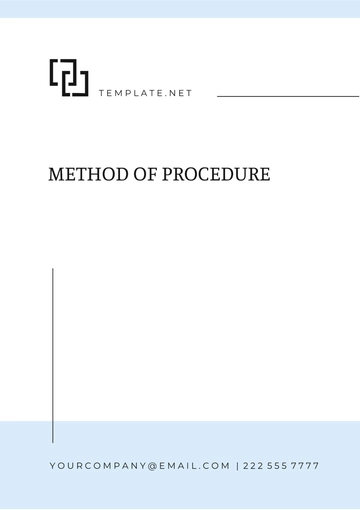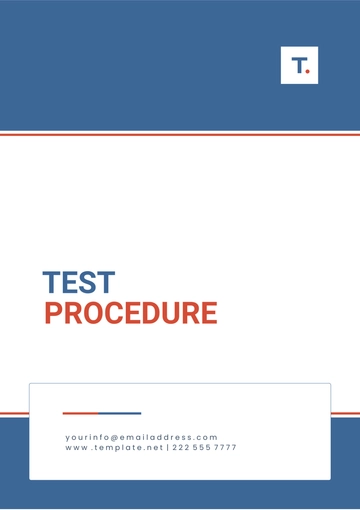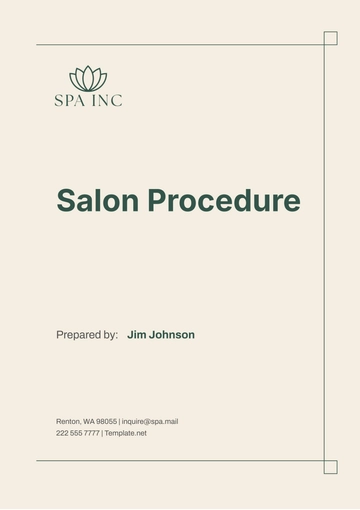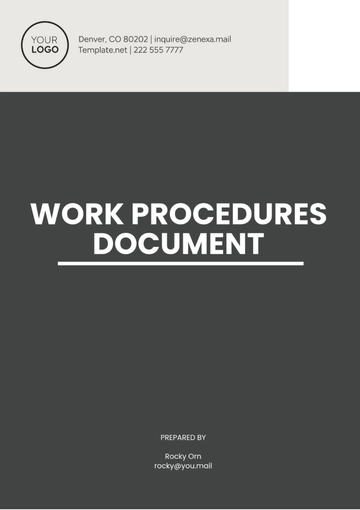Free Aesthetic Car Wash Fundraiser Standard Operating Procedure

I. Introduction
A. Purpose of the SOP
[Your Company Name]'s SOP aims to streamline the organization and execution of aesthetic car wash fundraisers, ensuring every event meets high standards of quality and efficiency. By standardizing procedures, we aim to enhance fundraising outcomes while providing a memorable experience for participants and supporters.
B. Scope of the SOP
[Your Company Name]'s SOP applies to all personnel involved in planning, organizing, and executing aesthetic car wash fundraisers under [Organization Name]. It encompasses guidelines for event logistics, volunteer management, customer engagement, and post-event evaluation to ensure consistency across all fundraising initiatives.
C. Objectives of the Aesthetic Car Wash Fundraiser
Maximize fundraising efforts by offering premium car wash services that attract a broad customer base.
Enhance community engagement and brand visibility through a visually appealing and well-executed event.
Establish a benchmark for future fundraisers by achieving financial goals and receiving positive feedback from participants and sponsors.
II. Pre-Event Planning
A. Event Conceptualization and Approval
The event coordinator will present a detailed proposal outlining the benefits of an aesthetic car wash fundraiser, including potential revenue projections and community impact. Approval will be sought from management, ensuring alignment with organizational goals and resources.
B. Setting Fundraising Goals
In order to determine clear financial targets for a fundraiser, it is essential to engage in a thorough and multifaceted process. This involves meticulously analyzing data from previous fundraising efforts to understand trends and outcomes. Additionally, it requires a careful consideration of the operational costs that the fundraiser will incur. Based on this comprehensive analysis, it is then possible to set goals that are both ambitious and achievable. By following these steps, one can ensure that the financial plan for the fundraiser is not only viable but also provides a solid benchmark for measuring success.
C. Selecting Date, Time, and Location
Careful consideration of optimal timing and location is essential for maximizing attendance and participant engagement. Factors such as local events, weather forecasts, and accessibility will be evaluated to choose a date and venue that best support the fundraiser's objectives.
D. Securing Permits and Permissions
Securing the essential permits from local governing bodies, as well as obtaining the requisite permissions from property owners, is crucial to ensuring that all legal regulations are adhered to. This not only helps in maintaining compliance with the law but also significantly bolsters the credibility of the event. Additionally, proactively coordinating with the relevant stakeholders well in advance plays a pivotal role in minimizing the risk of delays and facilitates a seamless planning process for the event.
E. Creating Budget and Cost Analysis
Creating a thorough and detailed budget entails projecting the costs associated with various necessary expenses such as renting equipment, producing and distributing promotional materials, providing refreshments for volunteers, and procuring operational supplies. Conducting an in-depth cost analysis is crucial as it guarantees financial transparency, allowing for a clear understanding of where funds are allocated. This process also facilitates proactive management of these expenses, ensuring that every financial decision contributes efficiently towards maximizing the net proceeds generated from the fundraising event.
III. Organizational Structure
A. Appointment of Event Coordinator
The event coordinator, who has been appointed by the management team, plays a pivotal role as the central point of contact for the fundraiser. This individual shoulders the comprehensive responsibility of overseeing every aspect associated with the event. Their duties encompass a wide range of tasks, such as orchestrating volunteer efforts to ensure smooth operations, acting as an intermediary with sponsors to maintain and secure necessary support, and rigorously ensuring that the event timelines and objectives are adhered to. By managing these multifaceted responsibilities, the event coordinator ensures that the fundraiser runs seamlessly and achieves its intended goals.
B. Formation of Volunteer Teams
Roles and Responsibilities
Volunteers will be assigned specific roles based on their skills and preferences, such as car wash attendants, customer greeters, donation collectors, and traffic marshals. Clear job descriptions will be provided to each volunteer to ensure clarity and efficiency during the event.
Training Requirements
Training sessions will cover event protocols, customer service standards, safety procedures, and the organization's mission. Volunteers will receive hands-on training to familiarize themselves with their roles and build confidence in delivering exceptional service.
IV. Marketing and Promotion
A. Developing Promotional Materials
A team will meticulously design an array of eye-catching promotional materials, which will include flyers, posters, and digital graphics. Each of these items will be crafted to clearly and effectively communicate the essential details about the upcoming event, specifically its purpose, date, and location. In addition to conveying this vital information, these materials will also serve to highlight and emphasize the organization's dedication to fostering community involvement. Through the use of clear and compelling messaging, these promotional items will strongly encourage and motivate members of the community to participate in the event.
B. Social Media and Digital Marketing Strategy
Utilizing social media platforms as part of our strategy will involve a multifaceted approach. This will include the development and maintenance of event pages tailored to provide comprehensive information about the fundraiser. Additionally, we will commit to posting regular updates to keep the community informed about progress and upcoming activities related to the fundraiser. Our social media strategy focuses on consistent engagement with followers through interactive content like polls and live Q&As. This aims to generate excitement and boost online event registrations. Additionally, we seek to enhance the fundraiser's visibility and impact locally and beyond.
C. Local Outreach and Community Engagement
Collaborations with local businesses, schools, and community groups will enhance outreach efforts through joint promotional activities and word-of-mouth endorsements. Personalized invitations and direct outreach will foster community support and encourage attendance at the event.
D. Partnerships and Sponsorship Opportunities
Pursuing sponsorship opportunities from businesses whose values align closely with those of the organization will entail presenting comprehensive sponsorship packages. These packages will include a variety of branding opportunities and forms of recognition that will be prominently displayed and acknowledged during the course of the event. By establishing these partnerships, the organization will not only secure much-needed financial backing, but will also bolster the event's credibility and increase its level of visibility within relevant audiences.
V. Logistics and Setup
A. Equipment and Supplies Needed
A detailed and comprehensive checklist of all necessary equipment and supplies will be meticulously compiled to guarantee complete readiness on the day of the event. This checklist will encompass an array of items, such as high-quality car washing materials essential for maintaining the best possible presentation and cleanliness of the vehicles. To avoid any logistical problems and ensure seamless operation, all necessary tools and attractive signage for efficient navigation and communication will be either rented or purchased well in advance, allowing for smooth execution of event activities and preventing any last-minute delays or shortages.
B. Site Preparation and Setup
Conducting a comprehensive site inspection will determine layout options and optimize space utilization for car wash stations, waiting areas, and customer traffic flow. Coordination with venue managers will secure necessary permissions and amenities for a seamless setup process.
C. Safety and Security Measures
Implementing stringent safety protocols will involve providing protective gear, such as gloves and goggles, for volunteers, and implementing traffic management strategies to ensure participant safety. Emergency procedures and evacuation plans will be communicated and practiced to mitigate risks effectively.
D. Traffic Flow Management
Designing a strategic traffic flow plan will streamline vehicle arrivals, departures, and service queues to minimize wait times and optimize customer satisfaction. Clear signage, designated service lanes, and volunteer guidance will facilitate smooth traffic management throughout the event duration.
VI. Customer Experience
A. Service Menu and Pricing Strategy
Offering a broad and varied selection of services combined with competitive pricing options guarantees a high level of flexibility and caters to the diverse preferences of customers. By maintaining clear and transparent pricing along with detailed service descriptions, businesses can effectively manage customer expectations. This clarity not only helps in setting accurate expectations but also creates opportunities for upselling additional products or services, thereby maximizing the potential for increased revenue.
B. Customer Interaction Guidelines
Individuals who choose to volunteer will participate in comprehensive training sessions designed to equip them with the skills necessary to deliver outstanding customer service. This training will cover essential practices such as greeting customers warmly, explaining services clearly, and addressing inquiries professionally, all aimed at fostering positive interactions and enhancing overall customer satisfaction.
C. Ensuring Aesthetic Appeal
Ensuring that an event space is visually appealing involves several key components, such as the use of branded signage, themed decorations, and well-organized service areas. These elements significantly contribute to enhancing the overall customer experience by creating a welcoming and aesthetically pleasing environment. Furthermore, upholding excellent cleanliness and carefully attending to details in the event space greatly contribute to projecting a positive image of the organization, showcasing its commitment to quality and ensuring a top-notch experience for attendees.
D. Handling Customer Feedback
Implementing a feedback system, such as comment cards or digital surveys, allows customers to share their experiences and suggestions. Promptly addressing feedback demonstrates responsiveness and promotes continuous improvement in service delivery and event management.
VII. Event Execution
A. Event Kick-off Procedures
The event coordinator will convene a comprehensive pre-event briefing session, meticulously designed to guarantee that every volunteer has a clear and thorough understanding of their specific roles and responsibilities. Following this preparatory meeting, the fundraiser will be formally inaugurated through a ceremonial kick-off. This opening ceremony is intended to establish an uplifting and enthusiastic ambiance, effectively galvanizing participants and uniting them around the overarching mission and goals of the organization.
B. Service Operations Workflow
Vehicle Arrival and Check-in
Volunteers will greet arriving vehicles, confirm selected services, and manage customer check-in efficiently. Clear communication and systematic check-in procedures will minimize wait times and enhance operational flow.
Car Wash Process
Trained attendants will perform thorough car wash services using high-quality products and techniques. Attention to detail and consistent service standards will ensure customer vehicles are cleaned to satisfaction.
Drying and Detailing
After washing, vehicles will be dried and detailed as per customer requests, ensuring a polished finish and customer delight. Additional services, such as interior cleaning or waxing, will be offered to enhance service value.
Payment and Donation Collection
Efficient payment processing methods, including cash, credit/debit cards, and digital payments, will be available. Volunteers will encourage customers to make additional donations, reinforcing the fundraiser's impact and financial goals.
C. Managing Volunteer Shifts and Breaks
A structured shift schedule will ensure adequate volunteer coverage throughout the event. Break areas with refreshments and rest facilities will support volunteers in maintaining energy levels and delivering consistent service.
D. Monitoring Weather Conditions (if outdoor event)
Continuous monitoring of weather forecasts will enable proactive adjustments to event logistics and customer safety measures. Contingency plans, such as temporary shelter or rescheduling options, will be in place to mitigate weather-related disruptions.
VIII. Post-Event Procedures
A. Clean-up and Site Restoration
Volunteers will collaborate in dismantling equipment, disposing of waste responsibly, and restoring the venue to its original condition. Timely cleanup efforts reflect organizational professionalism and respect for event hosts and community spaces.
B. Financial Reconciliation and Reporting
Accurate accounting of funds collected, expenses incurred, and net proceeds will be conducted promptly after the event. Financial reports will be prepared for internal review and stakeholder transparency, documenting fundraising achievements and financial accountability.
C. Evaluation and Lessons Learned
A post-event debriefing session will gather feedback from volunteers and organizers to assess event successes, challenges, and opportunities for improvement. Documenting lessons learned and best practices will inform future fundraising strategies and enhance organizational learning.
D. Acknowledgment of Volunteers and Sponsors
Gratitude will be expressed to volunteers for their dedication and contributions to event success. Sponsors and partners will be recognized through personalized acknowledgments and public appreciation, fostering continued support and partnership.
IX. Continuous Improvement
A. Review and Update SOP Annually
An annual review process will ensure this SOP remains current and responsive to evolving organizational needs and community feedback. Updates will be communicated to stakeholders to maintain consistency and effectiveness in future fundraising endeavors.
B. Incorporating Feedback for Future Events
Analysis of participant feedback and volunteer insights will drive continuous improvement in event planning, customer service, and operational efficiency. Actionable recommendations will be implemented to elevate future fundraising events and optimize community impact.
C. Documenting Success Stories and Best Practices
Compiling success stories, participant testimonials, and fundraising milestones will showcase the event's positive outcomes and organizational impact. Sharing documented best practices internally and externally will inspire ongoing support and engagement in future fundraising initiatives.
- 100% Customizable, free editor
- Access 1 Million+ Templates, photo’s & graphics
- Download or share as a template
- Click and replace photos, graphics, text, backgrounds
- Resize, crop, AI write & more
- Access advanced editor
Create an efficient blueprint for your next Aesthetic Car Wash Fundraiser with the Aesthetic Car Wash Fundraiser Standard Operating Procedure Template from Template.net. This editable and customizable SOP template ensures seamless event planning with its user-friendly features and AI Editor Tool integration, allowing you to tailor every detail to perfection for maximum fundraising impact.





























